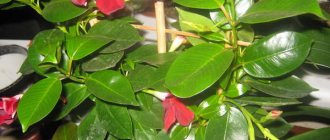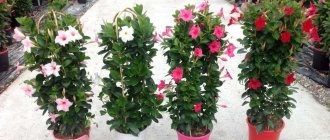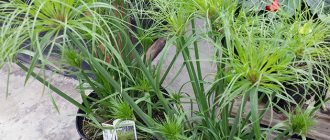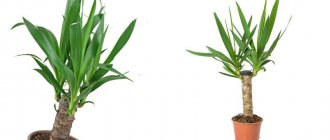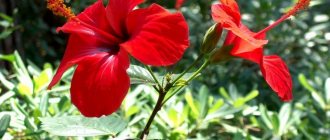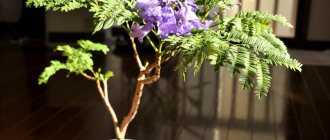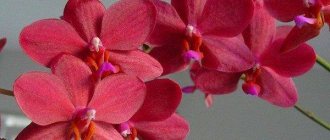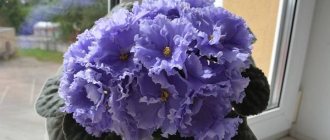Guest from South America - dipladenia
Dipladenia, or as it is also called mandevilla, is a decorative deciduous evergreen vine. It is still rarely seen in the collections of Russian amateur flower growers, but in vain. A compact vine with glossy bright green leaves is a real decoration for any interior. Dipladenia blooms almost all summer. Flowers measuring 10–12 cm are beautiful and fragrant.
In natural habitats there are real jungles of Dipladenia
The liana grows in the humid tropics of Brazil, Mexico, Bolivia and other countries in South and Central America.
The flower has two names - dipladenia and mandevilla. The first plants found in the forests of the South American continent were called Dipladenia. Later, other species of Dipladenia were discovered, but they were mistakenly classified as a separate genus, which received the name Mandeville, in honor of Sir Henry Mandeville, an English diplomat and gardener. And both names are still in use.
The liana has two names: Dipladenia and Mandevilla.
Dipladenia is a perennial with shiny, leathery leaves ending in a characteristic pointed tip. The plant has a tuberous rhizome.
Among the people, the liana has received several romantic names: it is called the Mexican tree of love and Bolivian rose, Chilean jasmine and Brazilian balsam.
Brazilian balsam flowers have a variety of colors - from snow-white to cherry-red. Some types of dipladenia have a very delicate aroma and bloom for a long time from May to the end of autumn, with each flower pleasing others with its beauty for about 10–12 days.
Dipladenia can grow exclusively in tropical climates. In our country, it is grown in greenhouse or indoor conditions. The flower is poisonous, all its parts contain dangerous substances, so it is not recommended to grow it where there are small children. When caring for Dipladenia, you must also be careful and wear gloves when carrying out pruning, watering and other procedures.
What does it mean if leaves turn yellow or fall off?
If mandevilla leaves turn yellow and fall off, it must be urgently isolated from other indoor crops. Such symptoms may indicate a flower disease or pest infestation.
Pests and control methods
Harmful insects such as whiteflies and spider mites cause great harm to the plant. Infestation by these pests can be determined by the following signs:
- Whitefly. It is clearly visible against the background of green leaves. These are small white midges the size of larvae. Whiteflies can infect a flower when airing it outside. All above-ground parts of the plant should be thoroughly washed under running water. If infection cannot be avoided, it is necessary to treat the flower with an insecticidal preparation.
Whitefly - Spider mite. The tick itself is almost impossible to notice, but the product of its activity - a thin web - is clearly visible. As a rule, the mite entangles it on the underside of the leaves and petioles. Spider mites appear in dry air conditions. It can only be eliminated with an insecticide.
Diseases and treatment
Most often, mandevilla is affected by root rot and powdery mildew. Root rot occurs due to waterlogging of the soil and stagnation of moisture in the tray of the pot. The disease manifests itself as yellowing and drying of the leaves and stems of the plant. The buds of the affected flower fall off without opening. The roots of the plant rot. You can get rid of rot in the early stages of its development. First, all affected parts are removed from the plant, then it is treated with a fungicide several times.
Powdery mildew is an equally unpleasant disease. It manifests itself as a white powdery coating, which over time covers the entire surface of the leaves. In the early stages of the disease, experienced gardeners advise wiping the affected leaves with lemon juice. If this does not help, it is necessary to combat the disease with fungicides.
From red to white: description of types and varieties of domestic mandevilla with photos
The genus Dipladenia has up to 40 species, but only a few of them are grown in captivity. Adapted best to indoor conditions:
- Dipladenia brilliantis is an ampelous plant with pubescent shoots reaching three meters in length. The leaf blades are about 20 cm in size. A network of veins appears on the surface. The buds are bright pink with purple bracts. There are 5–6 flowers in the raceme;
- Dipladenia superb is an incredibly graceful plant with slightly pubescent thin shoots and small leaves. Large flowers are painted in different shades of pink with bright red bracts and are collected 6-8 pieces in racemes;
- Dipladenia sandera is a beautiful liana with green pointed leaves, in the axils of which there are soft pink flowers about 8 cm in diameter with a yellow throat;
- Dipladenia Bolivianum is a plant with glossy small leaves and smooth stems. The liana blooms with white fragrant flowers, the diameter of which is 5 cm;
- Dipladenia friable is a powerful plant with warty shoots that naturally grow up to 6–7 meters. The leaves are colored gray-green. The flowers are snow-white or cream up to 5 cm in diameter. They emit a pleasant aroma.
Not only species of Dipladenia are grown indoors, but also numerous varieties, among which are:
- Allmand and Yellow, the flowers of which are painted in yellow shades;
- Cosmos White with snow-white large buds;
- Cosmos Pink, the flowers of which have a pinkish tone with a yellow throat;
- Cosmos Rose with double flowers;
- Classic Red, Cosmos Crimson King with gorgeous red flowers.
Photo gallery: Mandevilla splendor and other natural species
Dipladeniya brilliantis - ampelous plant with pink flowers
Snow-white flowers bloom on Dipladenia boliviana
Flowering of Dipladenia loose lasts six months
Dipladenia sandera - graceful vine with bright pink flowers
Dipladenia superb has small leaves
The work of breeders: dipladenia with yellow and double flowers in the photo
The Yellow variety is distinguished by large bright yellow inflorescences
Dipladenia variety Almand is strewn with fragrant yellow flowers
Dipladenia variety Classic Red has an original color: bright red petals are decorated with white stripes
Dipladenia flowers of the Cosmos Pink variety are pink in color and have a yellow throat
Cosmos Rose - variety with double flowers
How does it reproduce?
Reproduction of Dipladenia does not require much effort. Decorative vines can be propagated by cuttings. Thanks to such manipulations, it is possible to obtain lush flowering next year. The advantage of this flower is its rapid rooting in the soil substrate.
To do this, a small cutting is cut from the vine, the length of which should not exceed 15 cm. In the lower part near the buds, a cut is made at an angle of 45 degrees. Next, the planting material is placed in a container with root-forming preparations.
The final stage will be the creation of a greenhouse, inside which it is possible to maintain the required level of humidity. The photo of Dipladenia shows a young bush of an ornamental plant.
Table: conditions required for indoor liana
| Season | Lighting | Humidity | Content temperature |
| Spring Summer | Dipladenia is photophilous, but does not like direct sunlight. In summer, it is best to take the pot with the vine to the balcony. In the room, the ideal option would be to place it on an east-facing window. | Humidity is high. In hot weather, daily spraying with warm water is necessary. | +22–25°C |
| Autumn winter | Requires a very bright place and additional illumination with fluorescent lamps | Humidity 40–60%. It is advisable to place a household humidifier or a cup of water next to the vine | +15–17 °C |
Mandevilla types
Today, easy-care mandevillas fall into two main categories: climbing vines and mounds.
Vines are the old-fashioned type that all gardeners are generally familiar with. These plants quickly twine around trellises, arbors and other structures, making them valuable specimens for adding vertical color. Mandevilla vines rise up, wrapping their new growth around the support. It's important to know that they grow clockwise or counterclockwise, so be careful when tying them up. If a mandevilla grows clockwise and you wrap it counter-clockwise around its support, it will unwind on its own and fall over.
Different varieties of climbing mandevilla grow at different altitudes; the largest varieties tend to reach heights of up to 4.5m during the gardening season. Since they trail, you can make them grow horizontally or vertically.
Barrow mandevillas are newer varieties. Instead of trailing, they form neat clumps, making them ideal for use in garden and landscape beds and borders, as well as containers. Most Buzzards grow up to 1 meter in height and width and do not require support to climb. Because they have a bushier growth habit, they are also an excellent choice for hanging baskets and window boxes.
Recommendations for caring for mandevilla
To successfully grow a tropical beauty, it needs good care. The flower must be protected from drafts and provided with regular watering, spraying and fertilizing.
Watering with acidic water
Dipladenia, like all other tropical plants, needs abundant watering with warm water, but waterlogging should not be allowed, since stagnation of moisture can lead to rotting of the roots. In summer, the vine is watered every 2-3 days after the top layer of soil in the pot has dried. In winter, the number and volume of watering should be reduced.
In order for dipladeniya to bloom magnificently, it needs to be provided with abundant moisture.
It is recommended to acidify the water. To do this, add a little acetic or citric acid to the liquid. It is not difficult to check the degree of acidification; just taste it; the water should be slightly sour.
If acetic acid is used to acidify water, the liquid must stand in an open container so that the characteristic odor evaporates from it.
You need to constantly humidify the air
Brazilian balsam requires moist air. The plant must be frequently sprayed with warm water or installed next to the vine with a humidifier, a plate with wet pebbles, or an indoor fountain.
Necessary feeding
Since Dipladenia blooms profusely and for a long time, it requires a lot of nutrients. Fertilize the vine in the spring-summer period once every 2 weeks with complex mineral fertilizer for beautifully flowering plants. The drug Kemira Lux is perfect for this purpose.
Kemira Lux is a mineral fertilizer with a wide range of applications
The solution is made according to the instructions and applied to the soil 30 minutes after watering. In October, feeding is completely stopped.
Flowering period
In its natural environment, the liana can bloom all year round. “In captivity”, due to the reduction in daylight hours, mandevilla goes into a state of forced suspension of development and blooms again only in April-May.
Dipladenia blooms continuously for six months
The flowering period lasts six months, while buds are constantly formed. To prevent the plant from wasting extra energy, faded flowers must be periodically removed.
What to do in winter during the dormant period
For successful wintering, you need to prune the dipladenia at the end of October, leaving about 1/3 of the shoots on the plant. The liana is placed in a cool place with a temperature of +15–17 °C. Please note that the southern woman cannot tolerate temperatures below +12 °C. Hypothermia of the earthen clod is very dangerous, so it is recommended to place the pot with the vine in a wooden pot during the winter.
Watering in the fall is reduced. It is enough to moisten the earthen ball once a week. Feeding is canceled completely .
Correct cutting and shaping
Pruning mandevilla is a necessary technique that ensures abundant flowering, since buds form only on annual side shoots.
If you want a lush flowering plant, don’t be afraid to trim and pinch the dipladenia
The procedure is carried out in the fall, shortening all shoots by 2/3. In the spring, when the plant enters the phase of active growth, the tops are pinched for lush branching.
Brief description of cultivation
- Bloom . Lush and long-lasting (from the last days of March to November).
- Illumination . Needs bright but diffused light. It is recommended to place it on a windowsill with a western or eastern orientation.
- Temperature regime . During the growing season - from 18 to 26 degrees, and during the dormant period - from 12 to 15 degrees.
- Watering . It should be plentiful with a frequency of two or three times a week. The soil mixture in the pot is moistened only after its surface has dried to a depth of 10 to 15 mm. On very hot days, the bushes are sometimes watered twice a day. Starting in September, a gradual reduction in watering is carried out.
- Air humidity . Should be elevated. To do this, the flower is kept in a special glass display case, or the pot with the plant is placed on a tray filled with wet pebbles.
- Fertilizers . Feeding begins in March, from this time liquid nitrogen fertilizers are added to the substrate once every 7 days. However, with the beginning of the formation of buds, the flower should be fed with potassium-phosphorus complex fertilizer, which is applied systematically once a week until August.
- Trimming . It is carried out systematically in the autumn, immediately after the end of the growing season.
- Transplant . If necessary, after the root system of the bush becomes very crowded in the flower pot. Adult bushes are not replanted; instead, the top layer of soil mixture in the pot is regularly replaced.
- Reproduction . By cuttings and seed method.
- Harmful insects . Whiteflies, mealybugs and spider mites.
- Diseases . Powdery mildew.
Table: typical problems when growing plants, their causes and solutions
| What does the plant look like? | What is the reason | How to fix the situation |
| the plant sheds buds and leaves |
|
|
| not enough light |
|
| The plant is withering | lack of watering |
|
| Leaf blades turn yellow and fall off | the plant is too hot |
|
Pest infestation
Pests are another common problem that causes discoloration of Dipladenia leaves. Pests often breed on weak plants that are not properly cared for.
The following can provoke the development of pests:
- poor-quality soil (previously infected with pest larvae);
- unsuitable water;
- low room temperature;
- insufficient lighting;
- excess dust on the plant.
Common pests that can be found on mandevilla include:
- mealybug;
- whitefly;
- spider mite
Also found are aphids, nematodes, felt insects, and scale insects.
Leaf nematode
Aphid
Shchitovka
Spider mite
Spider mite
Spider mite is a pest that belongs to the order of arachnids. The main reason for its appearance is low air humidity.
The first sign of the disease is the formation of brown or black dots on the leaf blades. A yellow spot grows in the area of these points. The second sign of infection is a thin web covering the leaves. Pests are visible to the eye. They settle on the reverse side of the leaf.
To combat parasites, a slightly acidified soap solution is used. Dip a cotton pad into the mixture and wipe the Dipladenia leaf with it. An acidic environment allows you to get rid of the tick. If after the procedure the problem is not solved, then it is recommended to treat the flower with an acaricidal drug. Fitovert showed high efficiency.
To prevent re-infection, increase air humidity and periodically wipe the leaves with soapy water.
Whitefly
Whitefly
Some gardeners expose dipladenia to fresh air in the summer. This has a positive effect on flower growth, but can lead to whitefly damage. Before transferring the plant to your home, you must carefully examine the leaves and the pot itself.
The whitefly resembles a moth in appearance. She hides on the back of the leaf. An insecticidal drug is used to control the pest. Aktellik, Aktara, Fitovert showed high efficiency.
Even if no pests were found, experts recommend treating the plant before moving it into the house. This is due to high pest activity. They easily attack other indoor plants and lead to their death.
Mealybug
Mealybug
Mealybugs are pests that feed on the sap of the leaves and shoots of Brazilian jasmine. They not only undermine the plant’s strength, but also infect them with viral diseases.
The main causes of mealybugs include:
- the presence of larvae in the soil;
- poor quality water;
- low air temperature;
- bad light;
- dust on the leaves.
Symptoms include:
- withered leaves;
- deformation of buds and petals;
- the presence of small flying insects near the plant (reminiscent of mosquitoes);
- white crumbs in the soil (most noticeable during transplantation);
- the presence of white insects on the leaves.
Garlic tincture is used to combat the pest. To prepare it, pour a glass of boiling water over a twisted head of garlic. The tincture is ready in 4 hours. It is passed through a sieve. The leaves of Dipladenia are wiped with the liquid. Among the drugs, Aploud, Bi-58, and Phosfamide have proven themselves. They are used according to the instructions.
Table: pests and diseases that threaten dipladenia
| Disease or pest | Signs | Methods of disposal |
| Spider mite | The leaves become covered with small brown spots, then turn yellow, dry out and fall off. | If the damage is minor, remove the leaf and wipe the remaining leaves with acidified water and liquid soap. In case of significant damage, treatment with Fitoverm is necessary. |
| Mealybug | Cotton-like coating on leaves and shoots |
|
| Nematode |
|
|
| Powdery mildew | white coating on the upper surface of the leaf |
|
| Root rot |
|
|
Photo gallery: enemies of flowers and leaves - pests and diseases
A sign of powdery mildew is a white coating on the upper surface of the leaf.
Cotton-like growths on shoots and leaves are mealybug colonies
Necrotic spots on leaves are the result of nematode activity
With root rot, mold appears on the root collar
Spider mite. There are more than 40 species of these small mites with a round body of red or red color, which affect almost all plants
Propagation of Dipladenia by cuttings
A simpler and more affordable way is propagation by cuttings. There are two methods:
- Rooting in the ground. Cut at the node, in the active development phase, the young shoot is treated with a growth activator and planted in a mixture of sphagnum and peat. The sprout is provided with greenhouse conditions with regular moisture, ventilation and a germination temperature of 25-27 ºС. After about a month, the rooted cuttings with new leaves are planted in permanent soil.
- Rooting in water. Cuttings 5-6 cm long, cut slightly below the node, are dipped in a growth stimulant (for example, Kornevin) and placed in water with a charcoal tablet dissolved in it. With the appearance of callus growths, and this is usually a 3-week wait, the plant is planted in a mixture of azalea soil and coconut substrate. Next, the sprout is covered with a vessel with holes and placed in a warm place. Full roots appear already on the 4th day and the flower can be rooted in permanent soil.
How to propagate Brazilian balsam
Dipladenia propagates in three ways: cuttings, seeds and layering. Each has its own advantages and its own difficulties.
Root the cuttings
Dipladenia is often propagated at home by cuttings. This procedure is carried out in the spring. The stages are as follows:
- Young shoots are cut off from the plant. Each cutting should have 2-3 leaves.
- The cuttings are dipped into a solution of root formation stimulants Zircon, Heteroauxin or Kornevin.
- A mixture of peat and sand is poured into the container.
- The cuttings are planted in the substrate at an angle.
- The soil is moistened.
- The plantings are covered with a transparent lid to create greenhouse conditions and placed in a warm, bright place.
Plantings are covered with transparent covers to ensure greenhouse conditions - The cuttings are regularly watered and ventilated throughout the entire rooting period.
- After about a month, the lid is removed and care for the young plants continues.
About a month after planting, the cuttings take root - After two weeks, they are transplanted into separate pots and placed in a permanent place.
Root cuttings
Dipladenia propagation by layering is a very effective way. For this:
- Bend down a young, unformed shoot and pin it to the ground.
- After some time, roots will appear on it.
- After the roots appear, the new seedling is separated from the mother plant and planted in a separate container.
Try the seed method
Sometimes you can find Dipladenia seeds in specialized stores. For seed germination, it is important to maintain a high air temperature: from + 22 to + 28 degrees.
Seeds germinate only at high humidity and temperature
The seeds are sown in a light, slightly acidic substrate, moistened and covered with film. It can take 2–4 months for seeds to germinate; throughout the entire period, the crops are provided with heat, high humidity and light. After the emergence of seedlings, the film is removed and the seedlings continue to be cared for as adult specimens.
Video: how to propagate a flowering vine
Dipladenia: care at home. Briefly
Dipladenia at home is considered quite demanding to care for, but if you follow a number of growing rules, even inexperienced gardeners will succeed.
Basic care requirements:
| Temperature | Optimal in summer – 25 ºС, in winter – 10-15 ºС. |
| Air humidity | Quite high, at least 70-80%. |
| Lighting | Prolonged sunlight, south window or additional lighting. |
| Watering | Frequent, abundant in hot weather, in winter - as the soil dries out. |
| Soil for dipladenia | Light, permeable and nutritious soil. |
| Feeding and fertilizer | Twice a month with products for decorative flowering plants. |
| Dipladenia transplant | Every year in the spring, perennial flowers, and for young plants, replanting may be required 2 times a year. |
| Reproduction | By apical cuttings, less often by seeds. |
| Features of cultivation | The sap of the flower is poisonous, so care should be taken when caring for it. The plant requires support - the tendrils and the main branch should be directed upward and not droop. |
Video: Mandevilla
Sources
- https://tsvetem.ru/tsveti_v_dome/dipladeniya-uxod-v-domashnix-usloviyax.html
- https://ogorodniki.com/article/mandevilla-sorta-i-vidy-iarkogo-aktsentnogo-rasteniia
- https://vusadebke.com/cvetovodstvo/komnatnye-cvety-i-rasteniya/drugie-komnatnye/dipladeniya.html
- https://dacha.help/cvety/dipladeniya-mandevilla-tsvetushhaya-liana-korolevskih-krovey
- https://floragid.com/komnatnye/dipladeniya-vyrashhivanie-i-uxod.html
- https://podokonnik.temadnya.com/2360210440633976939/komnatnyj-tsvetok-dipladeniya-razmnozhenie-vyraschivanie-uhod-foto/
- https://ogorodnikam.info/dipladeniya-mandevilla-foto-vyrashchivanie-uhod-v-domashnih-usloviyah/
- https://o-remonte.com/dipladeniya-mandevilla-cvetok-opisan/
- https://pocvetam.ru/komnatnye-rasteniya/dipladenia-uhod-v-domasnih-usloviah.html
- https://podokonnik.temadnya.com/1684725592166763155/komnatnyj-tsvetok-dipladeniya-razmnozhenie-vyraschivanie-uhod-foto/
- https://komnatnyecvety.ru/dipladeniya/
- https://pion.guru/tsveti/uhod-za-dipladeniey
- https://obzorteka.ru/ogorod/dipladenija-uhod-v-domashnih-uslovijah-zimoj.html
- https://ogorodnash.ru/dipladeniya-uhod-v-domashnih-usloviyah/
- https://GardenGround.ru/domashnie/dipladeniya/
- https://pocvetam.ru/komnatnye-rasteniya/ampelnye-rasteniya/dipladenia-cvetok.html
Usefulness of the plant and harm
When caring for mandevilla, it is important to keep in mind that its strong-smelling sap is dangerous (in all parts of the plant). It is necessary to wear gloves when working with the plant. It is better not to have such a plant in a house where there are children and animals. Despite the disadvantages, there are still benefits from dipladenia. This plant forms the microclimate in the apartment. The plant absorbs carbon dioxide accumulated in the air and releases oxygen, absorbs harmful elements, microorganisms and dust formation. The invigorating smell emanating from homemade dipladenia flowers improves health, increases the body's activity and immunity. Dipladenia plant improves brain function and has a good effect on the respiratory system.
